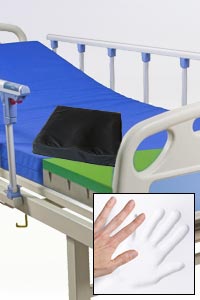KOHLAS, French manufacturer of bedsore prevention devices
Thanks to the expertise of
KOHLAS in mastering medical applications of viscoelastic foams and gels, the company offers a full range of bedsore prevention devices, specially designed to prevent and help treat pressure ulcers.
| |
 Shape memory foam or viscoelastic gel bedsore prevention seat cushions and mattresses.
Shape memory foam or viscoelastic gel bedsore prevention seat cushions and mattresses.
|
|
Compliance of VISCO'KARE bedsore prevention devices
Safe, all VISCO'KARE aproducts are formulated using only EC compliant components in accordance with Health Directive 93/42/EEC.
Pressure ulcers and bedsore preventnio devices
The pressure ulcer is a tissue necrosis due to a decrease of blood flow following an ischemic process (reduction of the arterial blood supply). If the origin of pressure ulcers is multifactorial, tissue compression associated with a loss of mobility and undernutrition plays a predominant role in its appearance.
Severity of pressure ulcer can take many forms that are classified in 4 stages:
- Stage 1
Reversible dermo-epidermal lesion characterised by a persistent erythema upon finger pressure that rapidly disappears after removal of the pressure on the affected area.
- Stage 2
Epidermal necrosis with blister or de-epidermisation. Epidermal layer is interrupted with a loss of both epidermis and dermis. Necrosis can take different forms: blister, abrasion or superficial ulceration.
- Stage 3
Dermo-epidermal necrosis that involve the entire thickness of the skin. The lesion is characterized by intense peripheral redness, an abundant and often foul-smelling outflow. At the initial stage, necrosis is a dry black plate, and, in later stages presents a fibrin yellow plate or shallow ulcer. Stage 3 pressure ulcer is prone to secondary infections or infections that can lead to the onset of fever.
- Stage 4
Necrosis is cutaneous and subcutaneous, reaching deep tissues: fascia, muscle, even the bone.
If the treatment of pressure ulcers can involve surgery, it is mostly medical and preventive. It is therefore essential to adapt bedsore prevetion devices to patient's morphology and condition, condition that can be evaluated according to different scales:
- The Braden scale
Simple and clear, the Braden scale takes into account factors.
| |
|
Completely limited
|
Constantly moist
|
Bedfast
|
Completely immobile
|
Very poor
|
Problème permanent
|
|
Very limited
|
Very moist
|
Chairfast
|
Very limited
|
Probably inadequate
|
Potential problem
|
|
Slightly limited
|
Occcasionally moist
|
Walks occcasionally
|
Slightly limited
|
Adequate
|
No apparent problem
|
|
No impairement
|
Rarely moist
|
Walks frequently
|
No limitation
|
Excellent
|
-
|
- The Norton scale
The simplest and oldest scale, the Norton scale does not take into account nutrition and was initially developped for patients aged of 65 or more.
| |
|
Very bad
|
Stupor
|
Bed bound
|
Immobile
|
Doubly
|
|
Poor
|
Confused
|
Chair bound
|
Very limited
|
Usually/Urine
|
|
Fair
|
Apathetic
|
Walk with help
|
Slightly impaired
|
Occasionally
|
|
Good
|
Alert
|
Ambulant
|
Full
|
Not
|
- The Waterlow scale
More complex, the Waterlow scale is rather intended for multidisciplinary practice and surgery.

